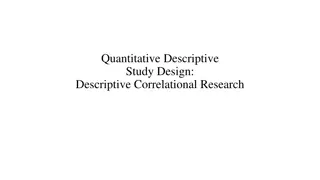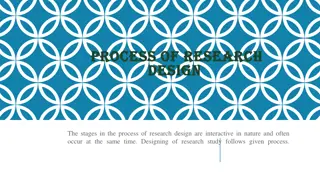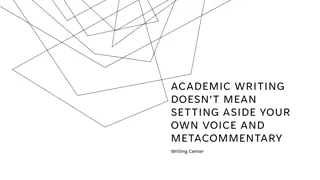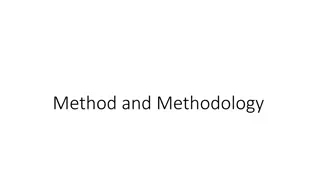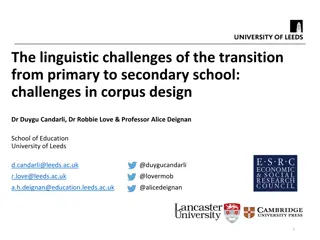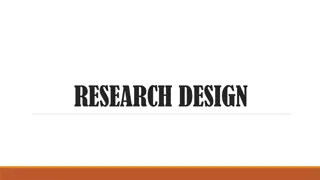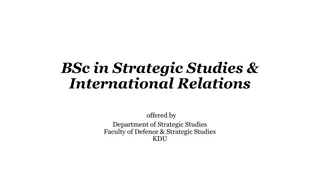Understanding Research Design in Academic Studies
Research design is the essential framework that guides the planning, implementation, and analysis of a study. It outlines how data will be collected, analyzed, and used to answer specific research questions or test hypotheses. The selection of a research design is crucial and depends on various factors such as the nature of the research problem, available resources, subject accessibility, and research ethics.
Download Presentation

Please find below an Image/Link to download the presentation.
The content on the website is provided AS IS for your information and personal use only. It may not be sold, licensed, or shared on other websites without obtaining consent from the author. Download presentation by click this link. If you encounter any issues during the download, it is possible that the publisher has removed the file from their server.
E N D
Presentation Transcript
Research Design Dr Muhammad Ibrar
Meaning and definition of Research Design The research design is the master plan specifying the methods & procedures for collecting & analyzing the needed information in a research study. Research design is a plan of how & where data are to be collected & analyzed. Research design is the researcher's overall plan for answering the research questions or testing the research hypotheses.
Contd. A research design is the framework or guide used for the planning, implementation, & analysis of a study. It is a systematic plan of what is to be done, how it will be done, & how the data will be analyzed. Research design basically provides an outline of how the research will be carried out & the methods that will be used.
Contd. Research design can be defined as a blue print to conduct a research study, which involves the description of research approach, study setting, sampling size, sampling technique, tool & methods of data collection & analysis to answer specific research questions or for testing research hypothesis.
Contd. It includes the descriptions of the research approaches, dependent variables, sampling design, & planning format for data collection, analysis & presentation. & independent
Elements of Research Design Qualitative Approach Quantitative Both Population, sample & sampling technique Methods of Analysis ELEMENTS Tools & Methods of Data Collection Time & Place Methods of Data Collection
Selection of Research Design Research designs are plans & the procedures for research that span the decisions from broad assumptions to detailed methods of data collection & analysis. In order to meet the aims & objectives of a study, researchers must select the most appropriate design.
Contd. The selection of a research design largely depends on the nature of the research problem, the resources available (cost, time, expertise of the researcher), accessibility of subjects, & research ethics. However, the main factors which affect the selection of research design are as follow:
Contd. 1. Nature of the research problem: This is the most important factor, which helps the researcher to decide about the selection of a research design. Based on the nature of research problem researchers decide whether it should be investigated through an experimental or non experimental approach. or phenomenon,
Contd. 2. Purpose of the study: Study may be conducted for the purpose of prediction, description, exploration, or correlation of the research variable. Therefore, the purpose of the research study helps the researcher to choose a suitable research design. 3. Researcher s knowledge & experience: Selection of research design is largely influenced by the researcher s knowledge & experience, because they avoid using those designs wherein they lack confidence, relevant knowledge, or experience.
Contd. 4. Researcher s interest & motivation: Interest & motivation levels help researchers decide about the particular research design(s). Motivated researchers always analyse most aspects of research design before selecting one or a combination, while casual & uncaring researchers may choose research design(s) that may lead to failure.
Contd. 5. Research incorporation & application of ethical & legal principles in the research design are essential. This includes moral obligations such as respect for participants & their rights, informed consent, & protection from harm, including any adverse effects to educational progress, health & well-being. ethics & principle: The
Contd. 6. Subjects/participants: The number & availability of study subjects may influence the selection of research design. If only few subjects are involved, an in-depth qualitative researcher may opt for qualitative research design. 7. Resources: None of the researcher can conduct without resources such as money, equipments, facilities, & support from colleagues. However, some of the studies require more amounts of resources as compared to others. Therefore, the selection of a research design may be affected by the availability of resources for the research study.
Contd. 8. Time: Time is also a major deciding factors for the selection of research design. For example, a researcher needs more time to conduct longitudinal studies, while cross-sectional studies may be conducted in shorter time. Therefore, time is contributing factor in selection of a research design. also a significant
Contd. 9. Users of the study findings: A research design also various methods of data collection & data analysis. Therefore, while choosing a research design, researcher must ensure that research design is as appropriate for the users of the study findings as possible, so that maximum advantage of the results can be obtained.
Characteristics of Research Design There are four key characteristics of research design: Neutrality: The results projected in research design should be free from bias and neutral. Understand opinions about the final evaluated scores and conclusion from multiple individuals and consider those who agree with the derived results.
Contd. Reliability: If a research is conducted on a regular basis, the researcher involved expects similar results to be calculated every time. Research design should indicate how the research questions can be formed to ensure the standard of obtained results and this can happen only when the research design is reliable.
Contd. Validity: There are multiple measuring tools available for research design but valid measuring tools are those which help a researcher in gauging results according to the objective of research and nothing else. The questionnaire developed from this research design will be then valid.
Contd. Generalization: The outcome of research design should be applicable to a population and not just a restricted sample. Generalization is one of the key characteristics of research design.
Types of Research Design There are three basic types of research design: 1. Exploratory 2. Descriptive 3. Causal
Contd. The goal of Exploratory research is to discover ideas and insights. Descriptive research is usually concerned with describing a population with respect to important variables. Causal research is used to establish cause-and- effect relationships between variables.
Important Tips 1 What is going on (Descriptive research)? 2 Why is it going on (Exploratory research)?
Exploratory Design Exploratory unstructured, informal research that is undertaken to gain background information about the general nature of the research problem. Exploratory research is usually conducted when the researcher does not know much about the problem and needs additional information or desires new or more recent information. research is most commonly
Contd. Exploratory research is conducted to provide a better understanding of a situation. It isn t designed to come up with final answers or decisions. Through exploratory research, researchers hope to produce hypotheses about what is going on in a situation. Exploration is particularly useful when researches lack a clear idea of the problems they will meet during the study.
Contd. Through exploration the researchers develop concepts more clearly, establish priorities, develop operational definitions, and improve the final research design. Exploratory research (sometimes referred to as qualitative research) shouldn t be expected to provide answers to the decision problem that you are attempting to solve for a client.
Contd. There are two reasons for this: (1) Exploratory research usually involves only a relatively small group of people, (2) these people are almost never randomly selected to participate. Exploratory research is used in a number of situations: To gain background information To define terms To clarify problems and hypotheses
Contd. A variety of methods are available to conduct exploratory research: Secondary Data Analysis Experience Surveys/Depth Interviews Case Analysis Focus Groups
Descriptive Design Descriptive research is undertaken to provide answers to questions of who, what, where, when, and how but not why. It is a research design in which the major emphasis is on determining the frequency with which something occurs or the extent to which two variables cover.
Contd. Descriptive researcher has much prior knowledge about the problem situation. In fact, a major difference between exploratory and descriptive research is that descriptive research is characterized by prior formulation of specific hypotheses. Thus the information needed is clearly defined. As a result, descriptive research is pre planned and structured. research assumes that the
Contd. we use descriptive research for the following purposes: 1. Major objective is to describe some thing usually market characteristics or functions 2. To describe the characteristics of certain groups. 3. To determine the proportion of people who behave in a certain way. 4. To make specific predictions 5. To determine relationships between variables


